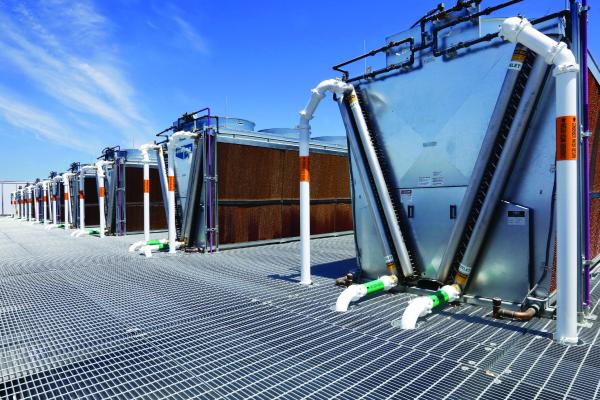Technology
This article will explore the Cooling Technologies Institute (CTI) Standard 201 (STD-201) Thermal Certification This article will explore the Cooling Technology Institute (CTI) Standard 201 (STD-201) Thermal Certification Program, share perspective from leading cooling tower manufacturers, and cover other existing and evolving CTI test codes, standards and certifications. This article will also emphasize the investment and bandwidth contributed to CTI by cooling tower manufacturers for the benefit of the industry and its end users.
Evaporative condensers are an efficient and cost-effective heat rejection solution for various applications—food and beverage refrigeration, industrial machinery cooling, and HVAC. The units work by condensing superheated refrigerant vapor inside a coil that is continually sprayed with water. As the water evaporates, fans reject the heated water vapor to the atmosphere. By lowering system condensing temperatures, evaporative condensers reduce compressor horsepower requirements, resulting in energy savings of up to 15% when compared to air-cooled systems.
[ Read Full Story ]
This is a two-part article looking at factors impacting decisions on whether to use air or water-cooled air compressors. It also provides heat recovery guidelines for both situations. Part 2 will provide a review of alternative cooling water system options and their approximate operating costs.
[ Read Full Story ]
The need for cooling capacity is increasing globally. An expanding population and an ever-growing dependence on data increases the need for process cooling, centralized space cooling, and data center cooling. Meanwhile, in many places, water scarcity is a massive issue. In conventional, industrial cooling applications, the use of water for heat rejection is critical. Cooling towers and most evaporative fluid coolers depend heavily on water to reject waste heat to the atmosphere.
[ Read Full Story ]
Water conservation is a high priority in designing and operating water-cooled equipment and plays an important role in USGBC’s Leadership in Energy and Environmental Design (LEED) certification and other sustainability programs. LEED assigns credit points to reduce water usage.
[ Read Full Story ]
This article will be of particular interest to industrial system operators unfamiliar with tankless (primarily closed) systems who may be considering either installing new systems without tanks or removing existing open tanks. The topics covered step through an understanding of tankless systems while also including tank system pointers and insights on converting systems with tanks into tankless systems.
[ Read Full Story ]
The 2023 AHR Expo co-sponsored by ASHRAE and AHRI was held Feb. 6-9 at the Georgia World Congress Center in Atlanta, GA. A total of 1,779 exhibitors (425 international) spread across 487,000 square feet, and several dozen free educational sessions drew 42,794 total attendees. HVACR equipment manufacturers and suppliers displayed their latest innovations engineered to address the megatrends in the HVACR industry and market. This report will highlight the cooling tower, chiller/heat pump and associated technology innovation centered around electrification, decarbonization and water conservation.
[ Read Full Story ]
The mission of CTI is to advocate and promote the use of all environmentally responsible commercial cooling technologies. Three committees make up CTI’s primary working groups - Engineering, Standards & Maintenance (ESM); Performance & Technology (P&T); and Water Treatment (WT). The conference featured over 35 presentations by recently published technical paper authors from the industry.
[ Read Full Story ]
This article will explore why tanks are used in cooling systems, why they might not be used in cooling systems, and finally considerations to be evaluated in determining if tanks are needed in any particular central plant cooling system. Part 2 will review specific application details for using tanks and also for tankless systems and system conversions.
[ Read Full Story ]
Chiller & Cooling Best Practices Magazine interviewed Glenn Brenneke, Vice President of Engineering and R&D, SPX Cooling Technologies, to discuss the Marley 100-year anniversary.
[ Read Full Story ]
An Illinois food service products manufacturer now saves nearly 60% of their base annual cooling energy costs through improvements made in three phases over several years. The plant, which has a 1200 ton chilled water plant, implemented upgrades including pump and tower fan VFDs and enhanced function controls, free cooling, and chiller compressor drive retrofits. The revisions built through successive phases to capture further benefits from more complete utilization of the preceding steps’ capabilities.
[ Read Full Story ]

